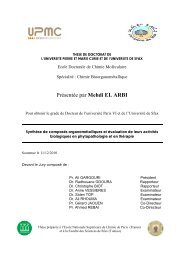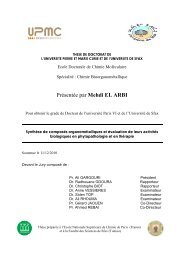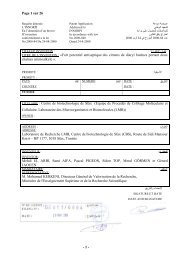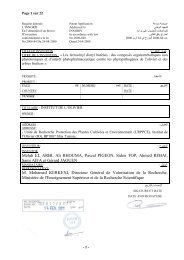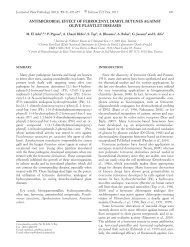A new series of ferrocifen derivatives, bearing two aminoalkyl chains
They possess the distinctive feature of combining a strong antiproliferative effect with intense antibacterial and antifungal activity
They possess the distinctive feature of combining a strong antiproliferative effect with intense antibacterial and antifungal activity
You also want an ePaper? Increase the reach of your titles
YUMPU automatically turns print PDFs into web optimized ePapers that Google loves.
Downloaded by University College Dublin on 29 June 2011<br />
Published on 28 June 2011 on http://pubs.rsc.org | doi:10.1039/C1NJ20192A<br />
NJC<br />
Cite this: DOI: 10.1039/c1nj20192a<br />
A <strong>new</strong> <strong>series</strong> <strong>of</strong> <strong>ferrocifen</strong> <strong>derivatives</strong>, <strong>bearing</strong> <strong>two</strong> <strong>aminoalkyl</strong> <strong>chains</strong>,<br />
with strong antiproliferative effects on breast cancer cellsw<br />
Pascal Pigeon, a Siden Top,* a Anne Vessie` res, a Michel Huche´, a Meral Görmen, a<br />
Mehdi El Arbi, a Marie-Aude Plamont, a Michael J. McGlinchey b and<br />
Ge´rard Jaouen* a<br />
Received (in Montpellier, France) 1st March 2011, Accepted 12th May 2011<br />
DOI: 10.1039/c1nj20192a<br />
We have prepared several organometallic systems whose structures are closely analogous to that<br />
<strong>of</strong> tamoxifen, the drug used in the treatment <strong>of</strong> hormone-dependent breast cancers, but which<br />
now possess <strong>two</strong> basic <strong>aminoalkyl</strong> <strong>chains</strong>: O(CH2)3NMe2. Despite the absence <strong>of</strong> a phenolic<br />
functionality, these ferrocenyl compounds 3, 4 and their organic analogue 5 recognize the<br />
estrogen receptor but in addition exhibit strong antiproliferative effects on hormone-dependent<br />
breast cancer cells (MCF-7), and also on hormone-independent ones (MDA-MB-231) with, in this<br />
case, an IC 50 value <strong>of</strong> about 0.4 mM. The ferrocenyl moiety does not create a major effect here<br />
compared to a purely organic aromatic group. On the other hand, the presence within the<br />
molecule <strong>of</strong> <strong>two</strong> vicinal basic entities, potentially allowing complexation to metal ions such as<br />
Zn 2+ , could perhaps be the key to the antiproliferative effectiveness <strong>of</strong> this <strong>series</strong> which operates<br />
via a different mechanism to that <strong>of</strong> hydroxytamoxifen 1 and hydroxy<strong>ferrocifen</strong> 2. The behaviour<br />
<strong>of</strong> these <strong>new</strong> species is discussed. They possess the distinctive feature <strong>of</strong> combining a strong<br />
antiproliferative effect with intense antibacterial and antifungal activity.<br />
Introduction<br />
The unusual reactivity <strong>of</strong> bioorganometallic species (complexes<br />
<strong>of</strong> biological interest incorporating a direct metal–carbon<br />
bond) is fuelling the emergence <strong>of</strong> a <strong>new</strong> organometallic-based<br />
approach to medicinal chemistry. 1–5 We have recently illustrated<br />
the potential <strong>of</strong> such a topic by changing the tamoxifen <strong>series</strong><br />
for <strong>ferrocifen</strong>s. 6–9 OH–Tam 1, via its pro-drug tamoxifen, is<br />
the medication most widely used to cure hormone-dependent<br />
breast cancers (Chart 1). 10–14 The main mechanism <strong>of</strong> action<br />
<strong>of</strong> this molecule is an antiestrogenic effect which occurs at low<br />
concentration (in the sub-micromolar range) via a specific<br />
interaction with the alpha form <strong>of</strong> the estrogen receptor (ERa).<br />
However non-genomic interactions, i.e. an effect not mediated<br />
by ER, have also been described, 15 but in this case the IC50<br />
value found for OH–Tam on an ER-negative cell line such as<br />
MDA-MB-231 is high (29 mM) and not useful for therapeutic<br />
purposes. 16 We have prepared a <strong>series</strong> <strong>of</strong> ferrocenyl analogues<br />
<strong>of</strong> OH–Tam by substituting the phenyl ring <strong>of</strong> OH–Tam, and<br />
a Ecole Nationale Supe´rieure de Chimie de Paris (Chimie ParisTech),<br />
Laboratoire Charles Friedel UMR CNRS 7223,<br />
11 rue Pierre et Marie Curie, 75231 Paris Cedex 05, France.<br />
E-mail: siden-top@chimie-paristech.fr,<br />
gerard-jaouen@chimie-paristech.fr;<br />
Tel: +33 1 43 26 95 55, +33 1 44 27 66 99<br />
b School <strong>of</strong> Chemistry and Chemical Biology, University College<br />
Dublin, Belfield, Dublin 4, Ireland<br />
w Dedicated to Pr<strong>of</strong>. Didier Astruc on the occasion <strong>of</strong> his 65th birthday.<br />
Dynamic Article Links<br />
View Online<br />
www.rsc.org/njc PAPER<br />
also varying the length <strong>of</strong> the amino side chain (n = 2, 3–5, 8),<br />
and found that the ferrocenyl derivative 2, with n =3,is<br />
highly cytotoxic to both hormone-dependent and hormoneindependent<br />
breast cancer cells (IC50 values in the range <strong>of</strong><br />
0.5 mM), while ferrocene itself has an IC 50 <strong>of</strong> 160 mM. 17–19 It<br />
has been hypothesized that the novel mechanism <strong>of</strong> action <strong>of</strong><br />
this Fc–OH–Tam 2 complex could involve the generation <strong>of</strong><br />
quinone methide owing to a conjugated redox ferrocenyl<br />
antenna. 20–22 Very recently we have fully characterized these<br />
quinone species and shown that they could be key metabolites<br />
explaining the different behavior between the organic and<br />
organometallic <strong>series</strong>. 23 In cancer therapy the discovery <strong>of</strong> a<br />
<strong>new</strong> type <strong>of</strong> mechanism is generally <strong>of</strong> interest. 24<br />
Access to quinone methides requires the presence <strong>of</strong> a<br />
phenolic group in the original structure. 20 However, it is also<br />
possible to generate these antiproliferative species when the<br />
phenol is replaced by an aniline since quinone imines are<br />
accessible via the same redox process triggered by the ferrocenyl<br />
antenna. 25,26 This poses the question as to the unequivocal<br />
character <strong>of</strong> such a mechanism. What happens if one blocks<br />
the generation <strong>of</strong> quinone methides by protecting the phenolic<br />
functionality <strong>of</strong> Fc–OH–Tam, by incorporating a second<br />
–O(CH2)3N(CH3)2 <strong>aminoalkyl</strong> chain identical to the one<br />
already present? This is the question we wished to examine.<br />
The first product tested in this <strong>new</strong> <strong>series</strong> was, for chronological<br />
reasons, the organometallic complex 3. 7 However,<br />
when we found that the ferrocenophanes are <strong>of</strong>ten more active<br />
This journal is c The Royal Society <strong>of</strong> Chemistry and the Centre National de la Recherche Scientifique 2011 New J. Chem.
Downloaded by University College Dublin on 29 June 2011<br />
Published on 28 June 2011 on http://pubs.rsc.org | doi:10.1039/C1NJ20192A<br />
than their open chain counterparts, 27,28 we included the cyclic<br />
compound 4. Finally, since the ferrocene in these structures<br />
can only operate conjugatively with difficulty to activate the<br />
redox activation process seen in Fc–OH–Tam, 2, we chose to<br />
add the purely organic molecule 5, where the aryl group is<br />
lipophilic but less bulky than the ferrocenyl entity. It is the<br />
totality <strong>of</strong> our results in this domain, leading to unexpected<br />
biological effects, that we present herein.<br />
Results and discussion<br />
Synthesis <strong>of</strong> the compounds<br />
The compounds 3, 4 and 5 were obtained by dialkylation <strong>of</strong><br />
the corresponding phenols 6, 7 and 8, respectively, with<br />
dimethylaminopropyl chloride hydrochloride (Scheme 1).<br />
The phenols themselves were prepared by the McMurry<br />
coupling procedure that we have used pr<strong>of</strong>itably in previous<br />
syntheses. 7,9,29<br />
The dialkylation <strong>of</strong> the diphenols 6 and 7 was carried out in<br />
DMF using sodium hydride as the base to form the diphenolate<br />
which, when heated at 90 1C with dimethylaminopropyl<br />
chloride hydrochloride, furnished 3 (20%), starting from 6,<br />
Chart 1<br />
and 4 (53%) from 7. Dialkylation <strong>of</strong> the diphenol 8 was<br />
carried out in acetone at reflux using K 2CO 3 as the base; the<br />
isolated yield <strong>of</strong> 5 was 64%.<br />
Biochemical studies<br />
The study <strong>of</strong> the effect <strong>of</strong> the three bis-dimethyl<strong>aminoalkyl</strong><br />
compounds 3, 4, 5 on the growth <strong>of</strong> hormone-independent<br />
(MDA-MB-231) and -dependent (MCF-7) breast cancer cells<br />
was performed together with the determination <strong>of</strong> their relative<br />
binding affinity (RBA) for ERa and <strong>of</strong> their lipophilicity.<br />
Results are reported in Table 1 and Fig. 1.<br />
Study <strong>of</strong> the antiproliferative effect <strong>of</strong> 3, 4 and 5 on<br />
MDA-MB-231 cells. The compounds show a strong antiproliferative<br />
effect on MDA-MB-231 which can be attributed to<br />
their cytotoxicity. Quite surprisingly these IC50 values are in the<br />
same range, around 0.40 mM, for the three compounds. This is<br />
absolutely not the case for their corresponding dimethylamino/<br />
phenol molecules, respectively, 1, 2 (Chart 1) and 9 (Chart 2)<br />
which have IC50 on MDA-MB-231 <strong>of</strong> 29, 0.5 and 0.015 mM. 16,18,31<br />
For the organic compound 5, replacement <strong>of</strong> the OH <strong>of</strong> 1 by a<br />
dimethylamino chain increases dramatically the cytotoxicity <strong>of</strong><br />
the compound (ratio = 85), it has almost no effect on the<br />
Scheme 1 Synthesis <strong>of</strong> the bis-dimethyl<strong>aminoalkyl</strong> compounds 3, 4 and 5.<br />
Table 1 Biochemical data <strong>of</strong> the compounds: IC50 values on hormone-independent breast cancer cells MDA-MB-231, relative binding affinity<br />
values (RBA) for ERa, enthalpy variation (DE) <strong>of</strong> the association <strong>of</strong> the molecules in the ERa binding site and lipophilicity (log Po/w)<br />
Compound IC50 (mM) MDA-MB-231 a<br />
RBA (%) on ERa b<br />
DE (kcal mol 1 )onERa log Po/w d<br />
View Online<br />
1 29 38.5 c<br />
151.2 3.2 (Z), 3.4 (E)<br />
3 0.45 0 2.8 0.1 89.5 3.56<br />
4 0.40 0.02 2.05 0.08 92.5 —<br />
5 0.34 0.05 54 12 136.3 3.86<br />
a After 5 days <strong>of</strong> culture. b Mean <strong>of</strong> <strong>two</strong> experiments performed on purified ERa, except for 1 (lamb uterus cytosol); the RBA value <strong>of</strong> estradiol,<br />
the compound <strong>of</strong> reference, is by definition equal to 100%. c RBA, value from ref. 9. d Measured as described in ref. 30.<br />
New J. Chem. This journal is c The Royal Society <strong>of</strong> Chemistry and the Centre National de la Recherche Scientifique 2011
Downloaded by University College Dublin on 29 June 2011<br />
Published on 28 June 2011 on http://pubs.rsc.org | doi:10.1039/C1NJ20192A<br />
Fig. 1 Effect <strong>of</strong> various concentrations <strong>of</strong> the compounds on the<br />
growth <strong>of</strong> hormone dependent breast cancer cells MCF-7 after<br />
72 hours in a medium without phenol red. Representative data <strong>of</strong> one<br />
experiment performed 3 times with similar results (six measurements<br />
limits <strong>of</strong> confidence).<br />
3/Fc–OH–Tam couple (ratio = 1.1), and it noticeably<br />
decreases in the ferrocenophane <strong>series</strong> (ratio = 0.04).<br />
Determination <strong>of</strong> the RBA values <strong>of</strong> the compounds for the alpha<br />
form <strong>of</strong> the estrogen receptor (ERa) and study <strong>of</strong> their effect on the<br />
growth <strong>of</strong> MCF-7 cells. All three molecules are recognized by the<br />
alpha form <strong>of</strong> the ER. This is a rather surprising result for these<br />
molecules lacking an OH group that is supposed to be one <strong>of</strong> the<br />
essential functional groups allowing the proper anchoring <strong>of</strong> a<br />
molecule in the ER binding site (Table 1). The high RBA value<br />
found for 5 was quite unpredictable and the decrease between 5<br />
and 3 and 4 can be attributed to the bulkiness <strong>of</strong> the ferrocenyl<br />
unit. However, the molecular modeling studies (vide infra)<br />
provide an explanation for this result.<br />
On MCF-7 cells, the three compounds show a slight, but<br />
reproducible, proliferative estrogenic effect at low concentrations<br />
(1 10 8 and 1 10 7 M; Fig. 1) after 72 h <strong>of</strong> incubation. In<br />
accordance to what is observed on MDA-MB-231 cells, they<br />
become highly cytotoxic at higher concentrations (between<br />
1 10 7 M and 1 10 6 M). We have previously noted this<br />
consecutive dual effect for other <strong>series</strong> <strong>of</strong> related complexes<br />
albeit possessing diphenolic functions. 28<br />
Molecular modeling<br />
Having seen that the three molecules 3, 4, 5 are recognized by<br />
ERa, we decided to use molecular modeling to establish the<br />
Chart 2<br />
View Online<br />
details <strong>of</strong> the molecule–receptor interaction. The structure<br />
used was that <strong>of</strong> the ligand binding domain (LBD) <strong>of</strong> ERa<br />
occupied by OH–Tam. 32 Only the amino acids that make<br />
up the wall <strong>of</strong> the cavity were retained. OH–Tam was<br />
then removed and replaced successively with 3, 4 or 5. An<br />
energy minimisation was then carried out, with the heavy<br />
atoms <strong>of</strong> the receptor immobilized, in order to establish<br />
the optimal position for the molecule within the active site.<br />
The Merck Molecular Force Field (MMFF) was employed<br />
for this purpose. Owing to the large number <strong>of</strong> atoms, in<br />
excess <strong>of</strong> the s<strong>of</strong>tware limit <strong>of</strong> 600 for quantum mechanical<br />
computations, the calculations were carried out using molecular<br />
mechanics rather than quantum mechanics. Energy variation<br />
values DE corresponding to the binding <strong>of</strong> the molecules<br />
within the active site <strong>of</strong> the receptor are shown in Table 1. It<br />
is interesting to note that these energy values are all very<br />
negative, indicating that binding <strong>of</strong> these molecules in the<br />
active site is possible. The value obtained for the organic<br />
compound 5 is very close to that <strong>of</strong> OH–Tam, although<br />
less for compounds 3 and 4, and is easily explained by the<br />
steric crowding <strong>of</strong> the ferrocenyl group. We note also that<br />
there is good correlation between these values and the RBA<br />
values.<br />
A visualization <strong>of</strong> the docking <strong>of</strong> 5 and <strong>of</strong> OH–Tam in the<br />
binding site <strong>of</strong> the estrogen receptor, in the antiestrogen<br />
conformation that corresponds to the interaction with<br />
OH–Tam, is shown in Fig. 2. This shows clearly that 5 and<br />
OH–Tam dock in a similar way inside the active site. The first<br />
anchor point <strong>of</strong> the ligand is an interaction between the<br />
nitrogen <strong>of</strong> the dimethylamino chain and the aspartic acid<br />
Asp 351. This is a strong hydrogen bond between the acid<br />
function and the terminal nitrogen <strong>of</strong> the chain, which, thanks<br />
Fig. 2 Docking <strong>of</strong> 5 (left) and OH–Tam (right) in the antagonist<br />
binding site <strong>of</strong> the a form <strong>of</strong> the human estrogen receptor (h-ERa).<br />
This journal is c The Royal Society <strong>of</strong> Chemistry and the Centre National de la Recherche Scientifique 2011 New J. Chem.
Downloaded by University College Dublin on 29 June 2011<br />
Published on 28 June 2011 on http://pubs.rsc.org | doi:10.1039/C1NJ20192A<br />
to the difference in their pKa, exist in the form <strong>of</strong> zwitterions,<br />
as shown in the following equation:<br />
In the case <strong>of</strong> OH–Tam the second anchor point is composed<br />
<strong>of</strong> <strong>two</strong> hydrogen bonds with Arg 394 and Glu 353 which,<br />
owing to their proximity, are also found as zwitterions. The<br />
first is a bond between the hydrogen atom <strong>of</strong> the phenol group<br />
and Glu 353 (in carboxylate form) and the second is a bond<br />
between the oxygen <strong>of</strong> the phenol group and Arg 394 (in the<br />
form <strong>of</strong> argininium) cf. below. Note that in Shiau’s structure, a<br />
molecule <strong>of</strong> water is also present at this level. 32<br />
In the case <strong>of</strong> 3, 4,or5, the phenol function no longer exists,<br />
which eliminates the first hydrogen bond, but the second can<br />
continue to exist, between the oxygen <strong>of</strong> the ether function <strong>of</strong><br />
the amino chain and the argininium. Owing to a displacement<br />
<strong>of</strong> the molecule within the active site, this is however less<br />
strong than with OH–Tam. Nevertheless, the whole structure<br />
is stabilized by the positioning <strong>of</strong> the aliphatic chain –(CH 2) 3–<br />
in a hydrophobic channel situated in this area. Overall,<br />
the replacement <strong>of</strong> the phenol function by the chain costs<br />
around 15 kcal mol 1 to the DE <strong>of</strong> the bond, but does not rule<br />
it out. These calculations provide a molecular basis for<br />
explaining both the RBA values <strong>of</strong> these compounds and<br />
their estrogenic effect as observed on hormone-dependent<br />
MCF-7 cells.<br />
Discussion<br />
We prepared a number <strong>of</strong> compounds selected from the<br />
<strong>ferrocifen</strong> and tamoxifen <strong>series</strong>, <strong>bearing</strong> <strong>two</strong> <strong>aminoalkyl</strong> <strong>chains</strong><br />
<strong>of</strong> the type O–(CH2)3N(CH3)2, and found that they showed a<br />
strong antiproliferative effect, probably linked to their cytoxicity,<br />
on both hormone-dependent and hormone-independent breast<br />
cancer cells. In this <strong>series</strong> the ferrocenyl unit does not seem<br />
to play a specific redox activating role but rather behaves as<br />
a compact aromatic unit similar to a lipophilic aryl group.<br />
Even though a ferrocene is a compact, lipophilic aromatic<br />
metallocene (see the log P o/w values <strong>of</strong> the compounds in<br />
Table 1), it is bulkier than a simple organic aromatic. This<br />
concept <strong>of</strong> bioisosterism has recently come to the fore to<br />
explain in part the behaviour <strong>of</strong> ferrocenyl groups in biology. 33<br />
In addition, we found recently that 3 and 5 show the same<br />
significant bactericidal and fungicidal effects (on P. aeruginosa,<br />
S. aureus and C. albicans). 34 Therefore, the driving force <strong>of</strong> the<br />
toxicity <strong>of</strong> these molecules on cancer cells, bacteria and fungi<br />
seems to be connected exclusively to the presence <strong>of</strong> <strong>two</strong><br />
<strong>aminoalkyl</strong> <strong>chains</strong>. This result differs from that reported for<br />
the ferrocenyl-diamine 10. In that case the ferrocenyl complex<br />
is active against the bacterium Mycobacterium tuberculosis<br />
while its organic equivalent, 11, is 8 times less effective. 35<br />
The toxicity <strong>of</strong> these compounds seems closer to that found<br />
for polyamines derived from putrescine and spermine than to<br />
that <strong>of</strong> our compounds. 36 We note also that cobaltifen 12<br />
(Chart 2) has been described and an IC 50 value <strong>of</strong> 2.5 mM was<br />
found on this same cell line, MDA-MB-231. 37 This value,<br />
more than six times higher than that <strong>of</strong> the compounds<br />
described here, can be explained by the presence <strong>of</strong> a very<br />
bulky organometallic group which dilutes the relative<br />
influence <strong>of</strong> the <strong>aminoalkyl</strong> <strong>chains</strong>.<br />
Finally, Japanese researchers have synthesized and studied<br />
ridaifen-B 13 (Chart 2). 38,39 This compound shows a potent<br />
antiproliferative effect on both MDA-MB-231 and MCF-7<br />
cells (IC 50 value <strong>of</strong> 1.3 mM after 48 h). In addition a<br />
COMPARE analysis performed on different cell lines<br />
revealed that the mechanism <strong>of</strong> action <strong>of</strong> this molecule<br />
differs from that <strong>of</strong> tamoxifen. They also showed that the<br />
toxicity <strong>of</strong> other symmetrical diamines was very similar. 38 This<br />
leads us to consider the origin <strong>of</strong> the significant toxicity<br />
demonstrated by this family <strong>of</strong> molecules.<br />
Since molecules 3, 4, 5 and 12 can be excellent complexing<br />
agents, we used molecular modelling to estimate their affinities<br />
with Zn 2+ , starting from the idea that this metal is strongly<br />
present in the cells and that its displacement, thanks to the<br />
presence <strong>of</strong> basic pincer groups, could lead to their malfunction.<br />
AZn 2+ cation was placed between the <strong>two</strong> amino <strong>chains</strong> <strong>of</strong> 3,<br />
4, and 5, and an energy minimisation was then carried out by<br />
the use <strong>of</strong> the Merck Molecular Force Field (MMFF) followed<br />
by semi-empirical quantum mechanical calculations (PM3).<br />
The DrH1 enthalpy <strong>of</strong> formation <strong>of</strong> the resulting complex was<br />
obtained, and then in each case, the complex was dissociated<br />
without geometric modification into <strong>two</strong> entities: a Zn 2+ cation<br />
and a molecule <strong>of</strong> 3, 4 or 5. The variations in DrH1 enthalpy <strong>of</strong><br />
the complexation were calculated from the equation:<br />
DrH1 = DrH1(complex) DrH1(molecule) DrH1(Zn 2+ ).<br />
A D rH1 value around 275 kcal mol 1 was obtained for all<br />
these compounds. This result confirms that these molecules<br />
are likely to be good complexing agents for divalent cations<br />
such as Zn 2+ as well as Ca 2+ . This hypothesis seems to<br />
be verified by the formation <strong>of</strong> a complex between 3 and<br />
ZnCl2. In fact, addition <strong>of</strong> one equivalent <strong>of</strong> ZnCl2 dissolved<br />
in THF to a THF solution <strong>of</strong> 3 led immediately to the<br />
formation <strong>of</strong> an orange oil at the bottom <strong>of</strong> the flask. Addition<br />
<strong>of</strong> water to this orange oil produced a yellow solution proving<br />
that the complex is partially soluble in water. The 1 H NMR<br />
spectrum <strong>of</strong> the complex in DMSO-d6 shows a slight deshielding<br />
<strong>of</strong> the protons <strong>of</strong> the CH 2CH 2NMe 2 group (1.83–1.98,<br />
2.46 and 2.48, 2.23 and 2.24 ppm, respectively) compared to<br />
that <strong>of</strong> 3 (1.78–1.94, 2.36 and 2.38, 2.16 and 2.17 ppm,<br />
respectively); the remaining protons are unchanged. Other<br />
complexing agents for dicationic metals such as hydroxamic<br />
acid, present at the end <strong>of</strong> the SAHA chain, have also been<br />
identified. 40–42<br />
Conclusion<br />
View Online<br />
We have shown that in the <strong>series</strong> <strong>of</strong> the OH–<strong>ferrocifen</strong>s, where<br />
the formation <strong>of</strong> quinone methides can give rise to a strong<br />
cytotoxic effect on cancer cells, there may be another possibility<br />
New J. Chem. This journal is c The Royal Society <strong>of</strong> Chemistry and the Centre National de la Recherche Scientifique 2011
Downloaded by University College Dublin on 29 June 2011<br />
Published on 28 June 2011 on http://pubs.rsc.org | doi:10.1039/C1NJ20192A<br />
<strong>of</strong> action if the phenol function is blocked by an <strong>aminoalkyl</strong><br />
chain that prevents the generation <strong>of</strong> quinone methides. This<br />
possibility is not specific to organometallic species since it is<br />
conserved when the metallocene is replaced by an organic<br />
arene. This means <strong>of</strong> access to <strong>new</strong> cytotoxic compounds will<br />
require <strong>new</strong> targets to be identified. This will be the subject <strong>of</strong><br />
further study, although several possible leads have been<br />
suggested here, such as the complexing role <strong>of</strong> <strong>two</strong> <strong>aminoalkyl</strong><br />
<strong>chains</strong> on metallic acid cations like Zn 2+ or Ca 2+ . We note<br />
that these entities combine an antitumoral effect with an<br />
antibiotic effect. 34<br />
Experimental<br />
General remarks<br />
All reactions took place under argon using standard Schlenk<br />
techniques. Anhydrous THF was obtained by distillation<br />
from sodium/benzophenone. Thin layer chromatography<br />
was performed on silica gel 60 GF254. Infrared spectra were<br />
obtained on an IRFT BOMEM Michelson-100 spectrometer<br />
equipped with a DTGS detector as a KBr plate. 1 H and 13 C<br />
NMR spectra were recorded on a 300 MHz Bruker spectrometer.<br />
Mass spectrometry was performed with a Nermag R<br />
10-10C spectrometer. Elemental analyses were performed by<br />
the microanalysis service <strong>of</strong> CNRS at Gif sur Yvette. HRMS<br />
measurements were performed by a Thermo Fischer LTQ-<br />
Orbitrap XL apparatus with an electrospray source.<br />
1,1-Bis[4-(3-dimethylaminopropoxy)phenyl]-2-ferrocenyl-but-1-ene, 3<br />
Compound 6 (0.424 g, 1 mmol) was dissolved in 10 mL <strong>of</strong><br />
DMF and sodium hydride (0.32 g, 8 mmol) was added. The<br />
mixture was stirred for 10 min, then 3-dimethylamino-1propyl<br />
chloride hydrochloride (0.375 g, 2.5 mmol) was added.<br />
The mixture was heated at 90 1C overnight. The mixture<br />
was cooled and 5 mL <strong>of</strong> ethanol were slowly added in order<br />
to destroy the remaining sodium hydride. Then, the mixture<br />
was concentrated under reduced pressure. The residue was<br />
dissolved in dichloromethane, washed twice with a diluted<br />
aqueous solution <strong>of</strong> sodium hydroxide followed with water.<br />
After drying on magnesium sulfate, the solution was concentrated<br />
under reduced pressure and the residue was chromatographed<br />
on silicagel with a 4/1 solution <strong>of</strong> chlor<strong>of</strong>orm/<br />
triethylamine as eluent to yield product 3 as an oil in 20%<br />
yield. An alternative route <strong>of</strong> synthesis <strong>of</strong> 3 was published<br />
recently. 34 1 H NMR (300 MHz, CDCl 3): d 0.94 (t, J = 7.4 Hz,<br />
3H, CH 3), 1.79–1.95 (m, 4H, CH 2), 2.18 (s, 6H, NMe 2), 2.19<br />
(s, 6H, NMe 2), 2.37 (t, J = 7.2 Hz, 2H, CH 2N), 2.40 (t, J =<br />
7.2 Hz, 2H, CH 2N), 2.50 (q, J = 7.4 Hz, 2H, CH 2), 3.83<br />
(t, J = 1.9 Hz, 2H, C5H4), 3.89 (t, J = 6.6 Hz, 2H, CH2O),<br />
3.91 (t, J = 6.6 Hz, 2H, CH2O), 3.98 (t, J = 1.9 Hz, 2H,<br />
C5H4), 4.02 (s, 5H, Cp), 6.66 (d, J = 8.7 Hz, 2H, C6H4), 6.77<br />
(d, J = 8.7 Hz, 2H, C6H4), 6.86 (d, J = 8.7 Hz, 2H, C6H4),<br />
7.02 (d, J = 8.7 Hz, 2H, C6H4). 13 C NMR (75 MHz, CDCl3):<br />
d 15.5 (CH3), 27.5 (CH2), 27.6 (CH2), 27.9 (CH2), 45.5<br />
(2NMe2), 56.5 (2CH2N), 66.1 (2CH2O), 67.9 (2CH C5H4),<br />
69.1 (5CH Cp), 69.3 (2CH C 5H 4), 87.2 (C C 5H 4), 114.1<br />
(2CH C 6H 4), 114.2 (2CH C 6H 4), 130.4 (2CH C 6H 4), 130.9<br />
(2CH C 6H 4), 136.5 (C), 137.2 (C), 137.3 (C), 137.4 (C),<br />
157.3 (2 C). IR (KBr, n/cm 1 ): 2948, 2868, 2816, 2764<br />
(CH2, CH3). MS (EI, 70 eV) m/z: 594 [M] + , 121 [CpFe] + ,<br />
86 [CH 2CH 2CH 2NMe 2] + , 58 [CH 2NMe 2] + . HRMS (ESI,<br />
C 36H 47FeN 2O 2: [M + H] + ) calcd: 595.29815, found:<br />
595.29681. The monoalkylated Fc–OH–TAM 2 was also<br />
isolated in 36% yield. Anal. Calcd for C 36H 46FeN 2O 2(H 2O):<br />
C, 70.54; H, 7.80; N, 4.67%. Found: C, 70.58; H, 7.90;<br />
N, 4.57%.<br />
1-[Bis(4-(3-dimethylaminopropoxy)phenyl)methylidene]-<br />
[3]ferrocenophane, 4<br />
View Online<br />
Compound 7 (0.422 g, 1 mmol) was dissolved in 10 mL <strong>of</strong><br />
DMF and sodium hydride (0.32 g, 8 mmol) was added. The<br />
mixture was stirred for 10 min, then 3-dimethylamino-<br />
1-propyl chloride hydrochloride (0.375 g, 2.5 mmol) was<br />
added. The mixture was heated at 90 1C overnight, then more<br />
3-dimethylamino-1-propyl chloride hydrochloride (0.375 g,<br />
2.5 mmol) was added. The heating was continued for 4 h.<br />
The mixture was cooled and 5 mL <strong>of</strong> ethanol were slowly<br />
added in order to destroy the remaining sodium hydride.<br />
Then, the mixture was cooled and concentrated under reduced<br />
pressure. The residue was dissolved in dichloromethane and<br />
was washed twice with a diluted aqueous solution <strong>of</strong> sodium<br />
hydroxide followed with water. After drying over magnesium<br />
sulfate, the solution was concentrated under reduced pressure<br />
and the residue was chromatographed on silicagel with a 4/1<br />
solution <strong>of</strong> chlor<strong>of</strong>orm/triethylamine as eluent. The residue<br />
was recrystallized from ethanol–water solution to yield product<br />
4 in 53% yield. Mp: 119 1C. 1 H NMR (300 MHz, CDCl3):<br />
d 1.75–1.87 (m, 2H, CH2), 1.87–2.13 (m, 2H, CH2), 2.17 (s, 6H,<br />
NMe2), 2.21 (s, 6H, NMe2), 2.24–2.31 (m, 2H, CH2 cycle),<br />
2.35 (t, J = 7.2 Hz, 2H, CH2N), 2.42 (t, J = 7.2 Hz, 2H,<br />
CH2N), 2.54–2.68 (m, 2H, CH2 cycle), 3.83 (t, J = 6.3 Hz, 2H,<br />
CH2O), 3.89 (s, 4H, C5H4), 3.94 (s, 2H, C5H4), 3.96 (t, J =<br />
6.3 Hz, 2H, CH 2O), 4.13 (s, 2H, C 5H 4), 6.53 (d, J = 8.3 Hz,<br />
2H, C 6H 4), 6.80 (d, J = 8.3 Hz, 2H, C 6H 4), 6.86 (d, J =<br />
8.3 Hz, 2H, C 6H 4), 7.05 (d, J = 8.3 Hz, 2H, C 6H 4). 13 C NMR<br />
(75 MHz, CDCl 3): d 27.5 (CH 2), 27.6 (CH 2), 28.7 (CH 2 cycle),<br />
41.1 (CH2 cycle), 45.4 (NMe2), 45.5 (NMe2), 56.4 (2CH2N),<br />
65.9 (CH2O), 66.1 (CH2O), 68.2 (2CH C5H4), 68.6 (2CH<br />
C5H4), 70.1 (2CH C5H4), 70.2 (2CH C5H4), 84.0 (C C5H4),<br />
86.8 (C C5H4), 113.1 (2CH C6H4), 114.0 (2CH C6H4),<br />
130.4 (2CH C6H4), 131.7 (2CH C6H4), 133.1 (C), 135.8 (C),<br />
136.2 (C), 140.2 (C), 157.1 (C), 157.7 (C). IR (KBr, n/cm 1 ):<br />
2943, 2856, 2814, 2763 (CH2, CH3). MS (EI, 70 eV) m/z: 592<br />
[M] + , 86 [CH 2CH 2CH 2NMe 2] + , 58 [CH 2NMe 2] + . HRMS<br />
(ESI, C 36H 45FeN 2O 2:[M+H] + ) calcd: 593.28250, found:<br />
593.28145. Anal. Calcd for C 36H 44FeN 2O 2(H 2O) 0.25: C, 72.42;<br />
H, 7.51; N, 4.69%. Found: C, 72.47; H, 7.54; N, 4.56%.<br />
1,1-Bis[4-(3-dimethylaminopropoxy)phenyl]-2-phenyl-but-1-ene, 5<br />
Compound 8 (1.58 g, 5 mmol) and potassium carbonate<br />
(2.764 g, 20 mmol) were stirred in 100 mL <strong>of</strong> acetone, then<br />
3-dimethylamino-1-propyl chloride hydrochloride (1.739 g,<br />
11 mmol) was added. The mixture was refluxed overnight,<br />
cooled and concentrated under reduced pressure. The residue<br />
was dissolved in dichloromethane then was washed twice with a<br />
diluted aqueous solution <strong>of</strong> sodium hydroxide followed with water.<br />
This journal is c The Royal Society <strong>of</strong> Chemistry and the Centre National de la Recherche Scientifique 2011 New J. Chem.
Downloaded by University College Dublin on 29 June 2011<br />
Published on 28 June 2011 on http://pubs.rsc.org | doi:10.1039/C1NJ20192A<br />
After drying over magnesium sulfate, the solution was<br />
concentrated under reduced pressure and the residue was<br />
recrystallized from ethanol–water solution to yield product 5<br />
in 64% yield. Mp: 91 1C. 1 H NMR (300 MHz, CDCl 3): d 0.84<br />
(t, J = 7.4 Hz, 3H, CH 3), 1.71–1.84 (m, 2H, CH 2), 1.84–1.98<br />
(m, 2H, CH 2), 2.13 (s, 6H, NMe 2), 2.18 (s, 6H, NMe 2), 2.30<br />
(t, J = 7.3 Hz, 2H, CH2N), 2.34–2.47 (m, 4H, CH2 +CH2N),<br />
3.78 (t, J = 6.4 Hz, 2H, CH2O), 3.94 (t, J = 6.4 Hz, 2H,<br />
CH2O), 6.45 (d, J = 8.8 Hz, 2H, C6H4), 6.67 (d, J = 8.8 Hz,<br />
2H, C6H4), 6.79 (d, J = 8.7 Hz, 2H, C6H4), 6.93–7.13 (m, 7H,<br />
C6H5 +C6H4). 13 C NMR (75 MHz, CDCl3): d 13.6 (CH3),<br />
27.5 (CH2), 27.6 (CH2), 29.0 (CH2), 45.2 (NMe2), 45.5 (NMe2),<br />
56.4 (CH2N), 56.5 (CH2N), 65.9 (CH2O), 66.1 (CH2O), 113.3<br />
(2CH C 6H 4), 114.0 (2CH C 6H 4), 125.9 (CH C 6H 5), 127.8<br />
(2CH arom), 129.7 (2CH arom), 130.6 (2CH arom), 131.9 (2CH arom),<br />
135.7 (C), 136.2 (C), 137.9 (C), 140.9 (C), 142.7 (C), 156.9 (C),<br />
157.7 (C). IR (KBr, n/cm 1 ): 2953, 2871, 2813, 2762 (CH 2,<br />
CH3). HRMS (ESI, C32H43N2O2:[M+H] + ) calcd: 487.33191,<br />
found: 487.33075. Anal. Calcd for C32H42N2O2(H2O)0.25: C,<br />
78.25; H, 8.72; N, 5.70%. Found: C, 78.26; H, 8.53; N, 5.46%.<br />
Complexation <strong>of</strong> 1,1-bis[4-(3-dimethylaminopropoxy)phenyl]-2ferrocenyl-but-1-ene,<br />
3, with ZnCl2<br />
Compound 3 (0.92 g, 1.55 mmol) was dissolved in 4 mL <strong>of</strong><br />
THF. A solution <strong>of</strong> ZnCl2 (0.21 g, 1.55 mmol) in THF (4 mL)<br />
was slowly added. An orange oil was immediately formed at<br />
the bottom <strong>of</strong> the flask. The solvent was removed to leave the<br />
Zn complex as an orange oil that was dried under vacuum.<br />
1<br />
H NMR (300 MHz, DMSO-d6) <strong>of</strong> compound 3 without<br />
addition <strong>of</strong> ZnCl2: d 1.02 (t, J = 7.2 Hz, 3H, CH3), 1.78–1.94<br />
(m, 4H, CH2), 2.16 (s, 6H, NMe2), 2.17 (s, 6H, NMe2), 2.36<br />
(t, J = 7.0 Hz, 2H, CH2N), 2.38 (t, J = 7.0 Hz, 2H, CH2N),<br />
2.49 (q, J = 7.2 Hz, 2H, CH2, partially hidden by DMSO),<br />
3.85 (s, 2H, C5H4), 3.96 (t, J = 6.2 Hz, 2H, CH2O), 4.00<br />
(t, J = 6.2 Hz, 2H, CH2O), 4.12 (s, 2H, C5H4), 4.15 (s, 5H, Cp),<br />
6.83 (d, J = 8.4 Hz, 2H, C6H4), 6.91 (d, J = 8.4 Hz, 2H, C6H4),<br />
6.93 (d, J = 8.4 Hz, 2H, C6H4), 7.12 (d, J = 8.4 Hz, 2H, C6H4).<br />
1<br />
H NMR (300 MHz, DMSO-d6) <strong>of</strong> compound 3 with<br />
addition <strong>of</strong> ZnCl2: d 1.02 (t, J = 7.2 Hz, 3H, CH3), 1.83–1.98 (m, 4H, CH2), 2.23 (s, 6H, NMe2), 2.24 (s, 6H,<br />
NMe2), 2.46 (t, J = 7.0 Hz, 2H, CH2N), 2.48 (t, J = 7.0 Hz,<br />
2H, CH2N), 2.49 (q, J = 7.2 Hz, 2H, CH2, partially hidden by<br />
DMSO), 3.85 (s, 2H, C5H4), 3.96 (t, J = 6.2 Hz, 2H, CH2O),<br />
4.00 (t, J = 6.2 Hz, 2H, CH2O), 4.12 (s, 2H, C5H4), 4.15<br />
(s, 5H, Cp), 6.83 (d, J = 8.4 Hz, 2H, C6H4), 6.91 (d, J =<br />
8.4 Hz, 2H, C6H4), 6.94 (d, J = 8.4 Hz, 2H, C6H4), 7.12<br />
(d, J = 8.4 Hz, 2H, C6H4).<br />
Biochemical experiments<br />
Materials<br />
Stock solutions (1 10 3 M) and serial dilutions <strong>of</strong> the<br />
compounds to be tested were prepared in DMSO just prior<br />
to use. Dulbecco’s Modified Eagle Medium (DMEM), fetal<br />
calf serum, glutamine and kanamycin were obtained from<br />
Invitrogen. MCF-7 and MDA-MB-231 cells were from the<br />
Human Tumor Cell Bank. Glutamine, 17b-estradiol and<br />
protamine sulfate were from Sigma.<br />
Determination <strong>of</strong> the Relative Binding Affinity (RBA) <strong>of</strong> the<br />
compounds for ERa<br />
RBA values were measured on ERa purchased from Pan Vera<br />
(Madison, WI, USA). A volume <strong>of</strong> 10 mL <strong>of</strong> the solution<br />
containing 3500 pmol mL 1 were added to 16 mL <strong>of</strong> buffer<br />
(10% glycerol, 50 mM bis-tris-propane pH 9, 400 mM KCl,<br />
2 mM DTT, 1 mM EDTA, 0.1% BSA) in a silanized flask.<br />
Aliquots (200 mL) <strong>of</strong> this solution in polypropylene tubes were<br />
incubated for 3 h at 0 1C with [6,7- 3 H]-estradiol (2 10 9 M,<br />
specific activity 1.62 TBq mmol 1 , NEN Life Science, Boston<br />
MA) in the presence <strong>of</strong> nine concentrations <strong>of</strong> the compounds<br />
to be tested. At the end <strong>of</strong> the incubation period, the free and<br />
bound fractions <strong>of</strong> the tracer were separated by protamine<br />
sulfate precipitation. The percentage reduction in binding <strong>of</strong><br />
[ 3 H]-estradiol (Y) was calculated using the logit transformation<br />
<strong>of</strong> Y (logit Y: ln[y/1 Y] versus the log <strong>of</strong> the mass <strong>of</strong> the<br />
competing steroid. The concentration <strong>of</strong> unlabeled steroid<br />
required to displace 50% <strong>of</strong> the bound [ 3 H]-estradiol was calculated<br />
for each steroid tested, and the results were expressed as<br />
RBA. The RBA value <strong>of</strong> estradiol is by definition equal to 100%.<br />
Culture conditions<br />
Cells were maintained in monolayer culture in DMEM with<br />
phenol red/Glutamax I, supplemented with 9% <strong>of</strong> decomplemented<br />
fetal calf serum and 0.9% kanamycin, at 37 1Cina5%<br />
CO2 air humidified incubator. For proliferation assays, cells<br />
were plated in 24-well sterile plates with 1.5 10 4 cells for<br />
MDA-MB-231 and with 3 10 4 cells for MCF-7 in 1 mL <strong>of</strong><br />
DMEM without phenol red, supplemented with 9% <strong>of</strong> fetal<br />
calf serum desteroided on dextran charcoal, 0.9% Glutamax I<br />
and 0.9% kanamycin, and were incubated for 24 h. The<br />
following day (D0), 1 mL <strong>of</strong> the same medium containing<br />
the compounds to be tested diluted in DMSO, was added to<br />
the plates (final volumes <strong>of</strong> DMSO: 0.1%; 4 wells for each<br />
condition). After three days (D3), the incubation medium was<br />
removed and 2 mL <strong>of</strong> fresh medium containing the compounds<br />
was added. At different days (D3, D4, D5 and D6),<br />
the protein content <strong>of</strong> each well was quantified by methylene<br />
blue staining as follows. Cell monolayers were fixed and<br />
stained for 1 h in methanol with methylene blue (2 mg mL 1 ),<br />
and then washed thoroughly with water. Two millilitres <strong>of</strong><br />
HCl (0.1 M) were then added, and the plate was incubated for<br />
1 h at 37 1C. Then the absorbance <strong>of</strong> each well was measured<br />
at 655 nm with a Biorad microplate reader. The results are<br />
expressed as the percentage <strong>of</strong> proteins versus the control.<br />
Experiments were performed at least in duplicate.<br />
Molecular modeling<br />
Molecular modeling studies were carried out using the<br />
programs Spartan, Trident and Odyssey. 43<br />
Acknowledgements<br />
View Online<br />
We thank Barbara McGlinchey for helpful discussions, and the<br />
Agence Nationale de la Recherche (ANR 2010BLAN706 1<br />
blanc, ) Mecaferol *) for financial support. M. G. acknowledges<br />
a fellowship from the Ministe` re des Affaires Etrangères (France).<br />
New J. Chem. This journal is c The Royal Society <strong>of</strong> Chemistry and the Centre National de la Recherche Scientifique 2011
Downloaded by University College Dublin on 29 June 2011<br />
Published on 28 June 2011 on http://pubs.rsc.org | doi:10.1039/C1NJ20192A<br />
References<br />
1 D. Dive and C. Biot, ChemMedChem, 2008, 3, 383–391.<br />
2 R. H. Fish and G. Jaouen, Organometallics, 2003, 22, 2166–2177.<br />
3 C. G. Hartinger and P. J. Dyson, Chem. Soc. Rev., 2009, 38,<br />
391–401.<br />
4G.Jaouen,Bioorganometallics, Wiley-VCH, Weinheim (Germany),<br />
2006.<br />
5 G. Jaouen, S. Top, A. Vessières and R. Alberto, J. Organomet.<br />
Chem., 2000, 600, 23–36.<br />
6 G. Jaouen, S. Top, A. Vessières, G. Leclercq and M. J.<br />
McGlinchey, Curr. Med. Chem., 2004, 11, 2505–2517.<br />
7 G. Jaouen, S. Top, A. Vessières, G. Leclercq, J. Quivy, L. Jin and<br />
A. Croisy, C. R. Acad. Sci., Ser. IIc: Chim., 2000, 3, 89–93.<br />
8 S. Top, J. Tang, A. Vessières, D. Carrez, C. Provot and G. Jaouen,<br />
Chem. Commun., 1996, 955–956.<br />
9 S. Top, A. Vessières, G. Leclercq, J. Quivy, J. Tang,<br />
J. Vaissermann, M. Huche´ and G. Jaouen, Chem.–Eur. J., 2003,<br />
9, 5223–5236.<br />
10 E. Badia, J. Oliva, P. Balaguer and V. Cavailles, Curr. Med. Chem.,<br />
2007, 11, 950–964.<br />
11 H. Gronemeyer, J. A. Gustafsson and V. Laudet, Nat. Rev. Drug<br />
Discovery, 2004, 3, 950–964.<br />
12 V. C. Jordan, J. Med. Chem., 2003, 46, 883–908.<br />
13 A. L. LaFrate, J. R. Gunther, K. E. Carlson and J. A.<br />
Katzenellenbogen, Bioorg. Med. Chem., 2008, 16, 10075–10084.<br />
14 M. J. Meegan and D. G. Lloyd, Curr. Med. Chem., 2003, 10,<br />
181–210.<br />
15 F. Zhang, P. W. Fan, X. Liu, L. Shen, R. B. van Breeman and<br />
J. L. Bolton, Chem. Res. Toxicol., 2000, 13, 53–62.<br />
16 D. Yao, F. Zhang, L. Yu, Y. Yang, R. B. van Breemen and<br />
J. L. Bolton, Chem. Res. Toxicol., 2001, 14, 1643–1653.<br />
17 E. A. Hillard, A. Vessières, L. Thouin, G. Jaouen and C. Amatore,<br />
Angew. Chem., Int. Ed., 2006, 45, 285–290.<br />
18 A. Nguyen, A. Vessières, E. A. Hillard, S. Top, P. Pigeon and<br />
G. Jaouen, Chimia, 2007, 61, 761–725.<br />
19 A. Vessières, S. Top, W. Beck, E. A. Hillard and G. Jaouen, Dalton<br />
Trans., 2006, 529–541.<br />
20 E. A. Hillard, P. Pigeon, A. Vessières, C. Amatore and G. Jaouen,<br />
Dalton Trans., 2007, 5073–5081.<br />
21 E. A. Hillard, A. Vessières, F. Le Bideau, D. Plazuk, D. Spera,<br />
M. Huche´ and G. Jaouen, ChemMedChem, 2006, 1, 551–559.<br />
22 A. Vessières, S. Top, P. Pigeon, E. A. Hillard, L. Boubeker,<br />
D. Spera and G. Jaouen, J. Med. Chem., 2005, 48, 3937–3940.<br />
23 D. Hamels, P. M. Dansette, E. A. Hillard, S. Top, A. Vessières,<br />
P. Herson, G. Jaouen and D. Mansuy, Angew. Chem., Int. Ed.,<br />
2009, 48, 9124–9126.<br />
View Online<br />
24 A. Vessières, C. Corbet, J. M. Heldt, N. Lories, N. Jouy, I. Laios,<br />
G. Leclercq, G. Jaouen and R. A. Toillon, J. Inorg. Biochem.,<br />
2010, 104, 503–511.<br />
25 P. Pigeon, S. Top, O. Zekri, E. A. Hillard, A. Vessières,<br />
M. A. Plamont, O. Buriez, E. Labbe, M. Huche, S. Boutamine,<br />
C. Amatore and G. Jaouen, J. Organomet. Chem., 2009, 694, 895–901.<br />
26 O. Zekri, E. A. Hillard, S. Top, A. Vessières, P. Pigeon,<br />
M. A. Plamont, M. Huche, S. Boutamine, M. J. McGlinchey,<br />
H. Muller-Bunz and G. Jaouen, Dalton Trans., 2009, 4318–4326.<br />
27 M. Go¨rmen, D. Plazuk, P. Pigeon, E. A. Hillard, M. A. Plamont,<br />
S. Top, A. Vessières and G. Jaouen, Tetrahedron Lett., 2010, 51,<br />
118–120.<br />
28 D. Plazuk, A. Vessières, E. A. Hillard, O. Buriez, E. Labbe,<br />
P. Pigeon, M. A. Plamont, C. Amatore, J. Zakrzewski and<br />
G. Jaouen, J. Med. Chem., 2009, 52, 4964–4967.<br />
29 S. Top, B. Dauer, J. Vaissermann and G. Jaouen, J. Organomet.<br />
Chem., 1997, 541, 355–361.<br />
30A.Nguyen,S.Top,P.Pigeon,A.Vessie` res, E. A. Hillard, M. A.<br />
Plamont, M. Huché, C. Rigamonti and G. Jaouen, Chem.–Eur. J.,<br />
2009, 15, 684–696.<br />
31 P. Pigeon, unpublished results.<br />
32 A. K. Shiau, D. Barstad, P. M. Loria, L. Cheng, P. J. Kushner,<br />
D. A. Agard and G. L. Greene, Cell, 1998, 95, 927–937.<br />
33 N. Metzler-Nolte and M. Salmain, in Ferrocenes: ligands, materials<br />
and biomolecules, ed. P. Stepnicka, John Wiley & Sons, Chichester,<br />
UK, 2008, pp. 499–639.<br />
34 M. El Arbi, P. Pigeon, S. Top, A. Rhouma, S. Aifa, A. Rebai,<br />
A. Vessières, M.-A. Plamont and G. Jaouen, J. Organomet. Chem.,<br />
2011, 696, 1038–1048.<br />
35 D. A. Ralambomanana, D. Razafimahefa-Ramilison, A. C.<br />
Rakotohova, J. Maugein and L. Pelinski, Bioorg. Med. Chem.,<br />
2008, 16, 9546–9553.<br />
36 R. A. Casero and P. M. Woster, J. Med. Chem., 2009, 52, 4551–4573.<br />
37 K. Nikitin, Y. Ortin, H. Muller-Bunz, M. A. Plamont, G. Jaouen,<br />
A. Vessières and M. J. McGlinchey, J. Organomet. Chem., 2010,<br />
695, 595–608.<br />
38 I. Shiina, Y. Sano, K. Nakata, T. Kikuchi, A. Sasaki, M. Ikekita,<br />
Y. Nagahara, Y. Hasome, T. Yamori and K. Yamazaki, Biochem.<br />
Pharmacol., 2008, 75, 1014–1026.<br />
39 Y. Nagahara, I. Shiina, K. Nakata, A. Sasaki, T. Miyamoto and<br />
M. Ikekita, Cancer Sci., 2008, 99, 608–614.<br />
40 R. W. Johnstone, Nat. Rev. Drug Discovery, 2002, 1, 287–299.<br />
41 P. A. Marks and R. Breslow, Nat. Biotechnol., 2007, 25, 84–90.<br />
42 H. Weinmann and E. Ottow, Annual Reports in Medicinal Chemistry,<br />
2004, vol. 39, pp. 185–196.<br />
43 Mac Spartan, Spartan, Trident and Odyssey, Wavefunction Co.,<br />
Irvine CA 92612, USA, http://www.wavefun.com/.<br />
This journal is c The Royal Society <strong>of</strong> Chemistry and the Centre National de la Recherche Scientifique 2011 New J. Chem.







